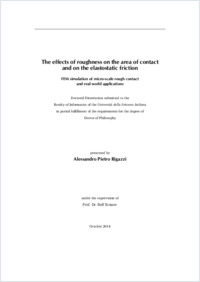The effects of roughness on the area of contact and on the elastostatic friction : FEM simulation of micro-scale rough contact and real world applications
- Rigazzi, Alessandro Pietro
- Krause, Rolf (Degree supervisor)
-
27.11.2014
152 p
Thèse de doctorat: Università della Svizzera italiana, 2014
English
Roughness is everywhere. Every object, every surface we touch or look at, is rough. Even when it looks smooth and flat, if analyzed at the proper length scale, it will reveal roughness. Thus, macro-scale, micro-scale, and even nano-scale roughness exist. What is even more fascinating, is that most of the rough structures, which can be observed at a given length scale, repeat themselves at smaller length scales, as in a fractal. The first implication of the rough nature of surfaces is that what we perceive as a full, solid, and smooth contact area, is in reality a collection of fragmented microscopical contact patches, composed of single contact points. Given its intrinsic complexity, the modeling of the real area of contact has been the subject of a huge amount of studies, which yielded different and contrasting results. As it is easy to imagine, the real area of contact is crucial for many real-world applications, such as the prediction of wear and fretting, charge and heat conduction, and frictional effect.Let alone think of how an acting load is normally believed to be uniformly distributed over the contact surface, and how variable and uneven it must, in reality, appear at microscopic length scales. The importance of roughness, together with our knowledge in parallel computing and fast solution methods, are the premises of the current work. In this study, we analyze rough contact between realistic surfaces, and we resolve it numerically at micro-scale, to understand its meso- and macro-scale effects. We do this by means of the Finite Element Method, in combination with an optimal multi-grid strategy and a spatial decomposition to perform the computations on highly parallel super-computers. We concentrate on the type of surfaces for which it is believed that molecular and chemical effects can be neglected.We simulate the contact between an elastic cube and diverse rigid rough surfaces, under different loading conditions, and we derive empirical laws which describe the influence of well known roughness parameters on important features such as contact evolution and static friction production. We also define bounds on the uncertainty of our measurements, to make clear the level up to which our predictions have to be considered reliable and applicable. Literature on roughness is densely populated by models, approaches, and theoretical predictions about the evolution of the real area of contact. An exhaustive comparison of our results with such corpus of works, articles, books, and theses would be infeasible. We therefore compare our results on the real area of contact to the predictions of two widely accepted theories (one by B. N. J. Persson, the other by A. W. Bush, R. D. Gibson, and T. R. Thomas), which have often proved to be interpretable as asymptotical bounds, for systems at low pressures. For large pressures, and consequent large areas of contact, we also compare our results to the newly developed and semi-empirical theory by Yastrebov, Molinari, and Anciaux. Finally, we test our method on the real world problem of tyre-asphalt interactions on wet roads, comparing the results obtained by our method to data from other studies, collected on real highways and runways, and to a theoretical model, which is close, in the assumptions, to our numerical experiments.
- Language
-
- English
- Classification
- Computer science and technology
- License
-
License undefined
- Identifiers
-
- RERO DOC 234500
- URN urn:nbn:ch:rero-006-113752
- ARK ark:/12658/srd1318601
- Persistent URL
- https://n2t.net/ark:/12658/srd1318601
Statistics
Document views: 384
File downloads:
- Texte intégral: 695
